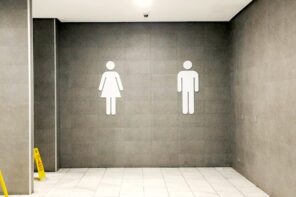In recent weeks, school boards across the country have become sites of conflict as organized anti-trans and anti-gay protests allied with calls for book bans to target actual and perceived LGBTQ+ content in education. They’ve been joined, in some cases, by conservative immigrant and religious communities. Some Muslims in Dearborn, Maryland and elsewhere have declared the existence of LGBTQ+ content in the curriculum a violation of their religious freedoms (though how exactly this represents a threat to religious freedom is left unanswered).
Vocal religious leaders may portray their personal beliefs as they wish, but they’re far from representative of the complexities of Islamic history or nuances of Muslim thought.
There’s a long history of gender nonconformity, queer love, and diverse gender expression in the Islamic world. In fact, for much of Islamic history, there was a great deal of tolerance for diverse expressions of gender and homoeroticism.
While Islamic law widely rebuked adopting the mannerisms of another sex in an affected manner—that is for mockery or imitation—it made space and accommodation for those whose mannerisms were khilqi, or innate. The 13th century scholar of jurisprudence, al-Nawawi writes:
“The scholars said effeminate men are two types. First, one who was created that way and he is not responsible for his behavior resembling women, their appearance, their speech, and their movements. Rather, Allah created upon him his disposition, so this is not blameworthy for him, nor a fault, nor a sin, nor is he punished.”
The nuance between affected and natural expression of gender reflects the historical reality: gender non-conforming people have been part of Islamic history from the very beginning.
Abu al-Faraj al-Isfahani’s Kitab al-Aghani records the lives of a number of individuals including one named Tuways who lived during the last years of Muhammad and the reigns of the early Muslim dynasties. Tuways was mukhannathun: those who were born as men, but who presented as female. They are described by al-Isfahani as wearing bangles, decorating their hands with henna, and wearing feminine clothing. One mukhannathun, Hit, was even in the household of the Prophet Muhammad.
Tuways earned a reputation as a musician, performing for clients and even for Muslim rulers. When Yahya ibn al-Hakam was appointed as governor, Tuways joined in the celebration wearing ostentatious garb and cosmetics. When asked by the governor if he were Muslim Tuways affirmed his belief, proclaiming the declaration of faith and saying that he observes the fast of Ramadan and the five daily prayers. In other words, al-Isfahani, who recorded the life of a number of mukhannathun like Tuways, saw no contradiction between his gender expression and his Muslimness. From al-Isfahani we read of al-Dalal, ibn Surayj, and al-Gharid—all mukhannathun—who lived rich lives in early Muslim societies. Notably absent from al-Isfahani’s records is any state-sanctioned persecution. Instead, the mukhannathun are an accepted part of society.
In the Abbasid caliphate many mukhannathun would become personal companions and courtiers of the caliph. Trained in the art of music, poetry, astronomy, and wit, no court was complete without them. According to ibn Mansur al-‘Abi, the mukhannathun became so valuable to the Islamic courts that one boasted: “We are the best of people, when we speak, you laugh; when we sing, you are ravished with delight; when we lie down, you mount.”
Far from isolated cases, across Islamic history—from North Africa to South Asia—we see widespread acceptance of gender nonconforming and queer individuals.
- Later in the Ottoman Empire, there were the köçek who were men who wore women’s clothing and performed at festivals. Formally trained in dance and percussion instruments, the köçek were an important part of social functions. A similar practice was found in Egypt. The khawal were male dancers who presented as female, wearing dresses, make up, and henna. Like their Ottoman counterparts, they performed at social events.
- In South Asia, the hijra were and are third-sex individuals. The term is used for intersex people as well as transgender women. Hijra are attested to among the earliest Muslim societies of South Asia where, according to Nalini Iyer, they were often guardians of the household and even held office as advisors.
- In Iraq, the mustarjil are born female, but present as men. In Wilfred Thesiger’s The Marsh Arabs the guide, Amara explains, “A mustarjil is born a woman. She cannot help that; but she has the heart of a man, so she lives like a man.” When asked if the mustarjil are accepted, Amara replies “Certainly. We eat with her and she may sit in the mudhif.” Amara goes on to describe how mustarjil have sex with women.
The complexity of gender is reflected in Islamic law itself as nearly every legal school and many Muslim scholars account for ambiguities of gender. Fatwas (i.e. legal rulings) and texts of jurisprudence account for khuntha, or individuals of unclear gender identity and/or intersex people, as well as mukhannathun. Regulations around inheritance, prayers, and religious obligations all indicate that Muslim scholars were far more comfortable with gender ambiguity than many would suspect—particularly in light of recent protests.
Historian Indira Gesink analyzed 41 medical and juristic sources between the 8th and 18th centuries and discovered that the discourse of a “binary sex” was an anachronistic projection backwards. Gesink points out in one of the earliest lexicography by the 8th century al-Khalil ibn Ahmad that he suggests addressing a male-presenting intersex person as ya khunathu and a female-presenting intersex person as ya khanathi while addressing an effeminate man as ya khunathatu. This suggests a clear recognition of a spectrum of sex and gender expression and a desire to address someone respectfully based on how they presented.
Tolerance of gender ambiguity and non-conformity in Islamic cultures went hand-in-hand with broader acceptance of homoeroticism. Texts like Ali ibn Nasir al-Katib’s Jawami al-Ladhdha, Abu al-Faraj al-Isfahani’s Kitab al-Aghani, and the Tunisian, Ahmad al-Tifashi’s Nuz’ha al-‘Albab attest to the widespread acceptance of same-sex desire as natural. Homoeroticism is a common element in much of Persian and Arabic poetry where youthful males are often the object of desire. From Abu Nuwas to Rumi, from ibn Ammar to Amir Khusraw, some of the Islamic world’s greatest poets were composing verses for their male lovers. Queer love was openly vaunted by poets. One, Ibn Nasr, immortalizes the love between two Arab lesbians Hind al Nu’man and al-Zarqa by writing:
“Oh Hind, you are truer to your word than men.
Oh, the differences between your loyalty and theirs.”
But it wasn’t just poets who valorized queer love and gender nonconformity, it was Muslim rulers themselves. The Abbasid Caliph al-Amin wrote passionate verses for his lover, Kawthar, who was famously either gender nonconforming or intersex.
According to Sahar Amer, the queen mother, Zubayda, concerned she would have no grandchildren hatched a plan to have the young women of the court dress as men. They became known as the ghulamiyya and became favorite companions of the caliph. Women presenting as masculine became widespread in the Abbasid court.
Similarly, in Al-Andalus, the wife of al-Hakam II presented as masculine, wearing men’s clothing, and adopting the name Ja’far. Then there was Al-Mu’tamid, the caliph of Seville, who had a tumultuous love affair with his vizier, the poet ibn Ammar.
Across the centuries there were many Muslim rulers who openly loved other men, from Mahmud of Ghazni to the Mughal Babur.
Acceptance of same-sex desire and gender non-conformity was the hallmark of Islamic societies to such a degree that European travelers consistently remarked derisively on it. In the 19th century, Edward Lane wrote of the khawal:
“They are Muslims and natives of Egypt. As they personate women, their dances are exactly of the same description as those of the ghawazee; and are, in like manner, accompanied by the sound of castanets.”
A similarly scandalized CS Sonnini writes of Muslim homoerotic culture:
“The inconceivable appetite which dishonored the Greeks and the Persians of antiquity, constitute the delight, or to use a juster term, the infamy of the Egyptians. It is not for women that their ditties are composed: it is not on them that tender caresses are lavished; far different objects inflame them.”
In his travels in the 19th century, James Silk Buckingham encounters an Afghan dervish shedding tears for parting with his male lover. The dervish, Ismael, is astonished to find how rare same-sex love was in Europe. Buckingham reports the deep love between Ismael and his lover quoting, “though they were still two bodies, they became one soul.”
The prevalence and acceptance of same-sex love was noted by anthropologists through the mid-20th century. Gill Shepherd writes, “In Mombasa, both male and female homosexuality is relatively common among Muslims, involving perhaps one in twenty-five adults.”
In the 19th century growing European dominance in the region began to align gender norms with that of Europe. Muslim modernists and reformers increasingly adopted Victorian sexual values and gender norms as signifiers of modernity. The Egyptian reformer Rifa’a al-Tahtawi wrote approvingly of the French:
“Amongst the laudable traits of their character… is their not being inclined toward loving male youth and eulogizing them in poetry, for this is something unmentionable for them and contrary their nature and morals.”
Tahtawi’s sentiments reflect the growing alignment of Muslim reformers with the thinking of people like C.S. Sonnini and other Europeans who saw the Islamic world’s tolerance of sexual diversity as a sign of its backwardness.
Today, vocal Muslim critics of LGBTQ+ rights often accuse gay and queer people of imposing a “Western” concept or forcing Islam to adjust to “Western values” failing to grasp the irony of the claim: the shift in the 19th and 20th century was precisely an alignment with colonial values over older Islamic ones, all of which led to legal criminalization. In fact, the common feature among nations with anti-LGBTQ+ legislation isn’t Islam, but rather colonial law.
Muslim countries like Iraq, Egypt, and Tunisia share a similar colonial experience with Christian countries like Ethiopia and Uganda. In most cases, the current laws on the books are the same colonial penal codes. Tunisia’s anti-sodomy laws are derived from the 1913 French Penal Code, while section 347 of the penal code in Christian Cameroon is a French colonial law. Similarly, the Ottoman adoption of French codes would ban the köçek. Across the Muslim world, many of the laws criminalizing LGBTQ+ people are direct relics of colonial law.
It would take generations to gradually align the region with European colonial sexual values through a shift in culture and imposed legal restrictions. Writing about Pakistan, the anthropologist Lindholm remarks:
“Homoerotic relationships were much more common a generation ago than they are now, since Western influence has brought a sense of shame about homosexuality, at least among the more educated.”
A similar change swept through Iraq in the 1960s according to psychiatrists Ihsan al-Issa and Brigitta al-Issa:
“The previous almost complete acceptance of homosexual practices is now undergoing some change. Some students who had been brought up in the old traditional pattern have expressed anxiety to the authors about their homosexual practices in the university student hostels in Baghdad.”
Clearly what today passes for sexual conservatism in regards to gender nonconformity and homoeroticism in much of the Islamic world has more to do with 19th and 20th century European sexual values than it does the Islamic sexual ethos.
Despite this, there’s a concerted effort by some conservative Muslims to portray Islamic thought on matters of sexuality as monolithic, insisting on a singular interpretation of sex and sexuality that makes no room for gay, trans, or gender nonconforming Muslims. If it were true that the Islamic world consistently and unambiguously viewed gay, gender nonconforming, and trans people as condemnable, then they did a pretty strange job showing that given the deep and rich history.
Of course, the erasure of that history is likely the point.





